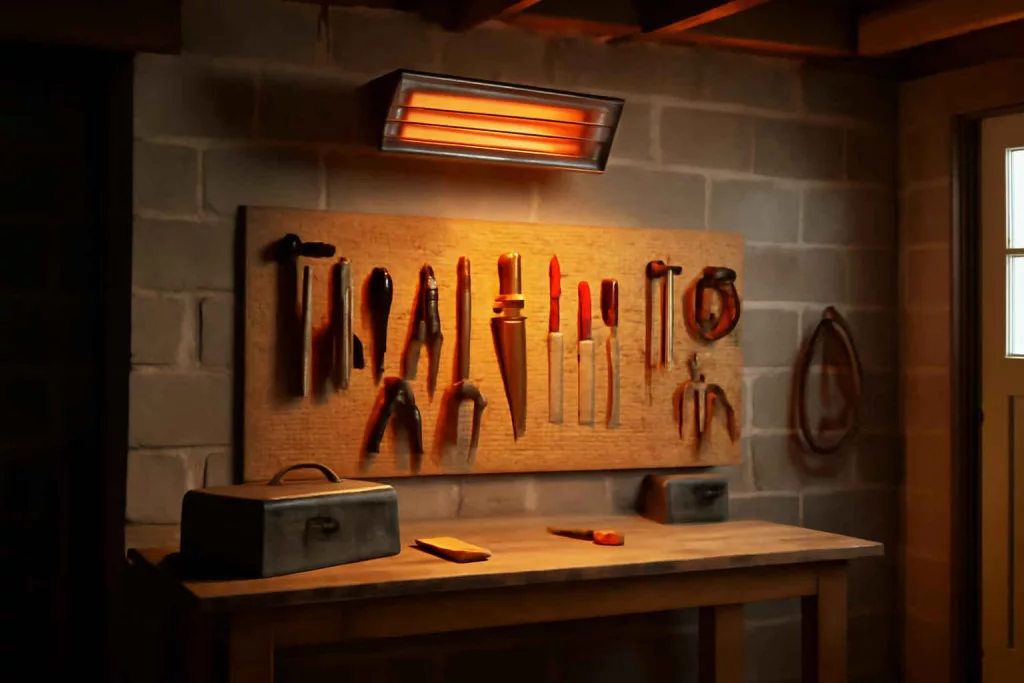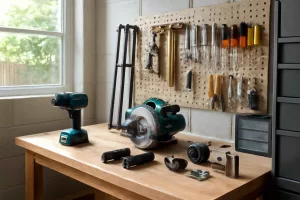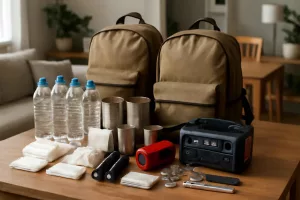Your unheated garage workshop can become a comfortable, productive space even in the coldest months with the right infrared garage heater. Infrared heaters work by emitting radiant heat that warms objects and people directly, rather than heating the air. This approach is ideal for drafty or poorly insulated garages because the warmth reaches you instantly and is not lost to air currents. Ready to browse top-rated infrared garage heaters? Check options on Amazon here.
Selecting the Right Infrared Garage Heater
Choosing an infrared garage heater requires evaluating the size of your workshop, mounting options, power availability, and the level of portability you need. For small to medium-sized garages up to 500 square feet, a single 4,000W hardwired infrared panel can deliver sufficient heat. Larger spaces may benefit from multiple 6,000W ceiling-mounted units or a combination of fixed and portable models. Consider ceiling height as well: low ceilings (under 8 feet) work best with wall-mounted infrared heaters, while higher ceilings benefit from overhead units that distribute heat downward.
Next, check your electrical panel capacity. Hardwired infrared heaters typically require a dedicated 240V circuit. If your panel is full, you might choose a 120V plug-in infrared heater that runs off a standard outlet. Portable electric infrared heaters offer flexibility—simply roll the unit to a new location and plug it in. However, they may not deliver the same heat output as hardwired options.
Durability is another factor. Look for corrosion-resistant housings and IP-rated casings if your garage has moisture or dust exposure. For cleaner setups, sleek powder-coated steel or aluminum panels integrate seamlessly into any workshop décor. Finally, check safety features like built-in thermostat controls, overheat protection, and tip-over shutoff on portable units. Once you’ve narrowed down your needs, you can compare specific models with confidence.
Why Choose Infrared Garage Heaters
Infrared technology is ideal for workshop heating solutions because it delivers heat directly to objects and people, eliminating the need to preheat the entire space. Unlike forced-air heaters, which warm the ambient air and can lose heat through drafts, infrared heaters create a more consistent temperature at the workbench or machinery zones. This targeted warmth reduces energy waste and allows you to stay productive without waiting for minutes or even hours of preheating.
Additionally, infrared heaters operate almost silently since they lack blowers or fans. This quiet operation is perfect for workshops where precision work, such as woodworking or electronics assembly, requires concentration. The lack of moving parts also means less maintenance over time, giving you a reliable system season after season.
Another advantage is the instant-on heat. As soon as you switch on the heater, you feel the warmth, making quick stops in the garage more comfortable. Because infrared heat penetrates surfaces, it helps maintain a stable floor temperature, preventing tools or adhesives from becoming too cold during winter projects.
Finally, modern infrared garage heaters are designed for easy integration into existing spaces. Whether you choose a slim wall-mounted panel or a low-profile ceiling unit, installation is straightforward, and the aesthetic design won’t clash with your workshop’s tool storage or workbench arrangements.
Top Infrared Garage Heaters Compared
When comparing infrared garage heaters, consider wattage, mounting style, control options, and coverage area. Below are three popular configurations that meet a range of workshop needs:
- Hardwired Wall-Mounted Panels: These low-profile units deliver between 3,000W and 6,000W of continuous infrared heat. Brands like Dr. Infrared and Heat Storm offer thermostatic control and remote operation. Wall-mounted panels are ideal for workshops with 8-10 foot ceilings and can comfortably heat up to 500 square feet each.
- Ceiling-Mounted Infrared Units: Overhead heaters, such as those from KING or Infratech, mount flush to the ceiling and direct heat downward in a 120-degree pattern. A single 6,000W ceiling-mounted heater can warm a 600–800 square foot area. These units keep floors and workbenches clutter-free.
- Portable Electric Infrared Heaters: For flexibility, portable heaters like the Dr. Infrared Portable Garage Heater offer 4,000W of power in a wheeled housing. Simply roll the unit to where you need heat most. Although they require standard 120V outlets, they often feature built-in thermostat controls and overheat protection.
To drill deeper into garage-ready lighting solutions that pair well with your heater selection, check out our guide to LED work lights for workshops.
Installation Guide for Infrared Garage Heaters
Installing an infrared garage heater requires planning, basic electrical knowledge, and a few specialized tools. Begin by mapping out mounting locations: wall-mounted panels should be at least 6-8 feet above the floor, clear of exposed wiring, shelving, or flammable materials. Ceiling units need at least 18 inches of clearance above the top of the heater to comply with safety standards.
Next, determine wiring needs. Hardwired infrared heaters typically require a dedicated 240V circuit with appropriately sized breakers. If your existing panel has a free slot, you can run a new 10/2 or 8/2 gauge wire (depending on heater amperage) from the breaker to the mounting point. Be sure to turn off power at the main breaker before handling any electrical connections. When in doubt, consult a licensed electrician to ensure code compliance.
Once wiring is in place, attach the mounting bracket according to manufacturer instructions. Use a stud finder to locate secure anchoring points. After securing the bracket, hang the heater and tighten all fasteners. Complete the electrical connections, using UL-listed wire connectors and cable clamps to prevent strain on the terminals. Finally, set the heater’s thermostat and test the unit. The infrared panel should emit a gentle red glow and warmth within seconds.
For additional workshop maintenance advice—such as repairing cracks or leveling the floor after heater installation—see our garage floor maintenance guide.
Energy Efficiency and Cost Savings
Infrared garage heaters are among the most energy-efficient options for heating workshops, thanks to their direct radiation of heat. By warming surfaces rather than air, these units achieve up to 90% efficiency compared to 60–70% for forced-air heaters. This efficiency translates into lower energy bills, especially when you only heat specific zones for focused projects.
Many infrared heaters come with programmable thermostats or smart controls, allowing you to schedule operation during peak work hours. By avoiding unnecessary run times, you reduce energy consumption by up to 30%. Additionally, pairing your heater with proper insulation—such as sealing cracks and adding weatherstripping—further cuts wasted heat. This combination of targeted infrared warmth and improved building envelope can pay for itself within one to two heating seasons.
To calculate potential savings, compare the wattage of your chosen heater to your local electricity rates. For example, a 4,000W heater running four hours per day at $0.12 per kWh costs roughly $1.92 per day. If you upgrade to a 6,000W unit and incorporate a programmable thermostat, you might operate only three hours daily, keeping costs stable while enjoying greater comfort.
Safety Tips and Maintenance
Maintaining safe operation and extending the lifespan of your infrared garage heater involves routine inspections and simple cleaning tasks. Every season, turn off power and allow the heater to cool. Inspect the housing for dust buildup and vacuum any debris from the vents. Check mounting brackets for loosened bolts and retighten as needed.
Keep a clearance of at least three feet around the heater’s front and sides. Avoid placing combustible materials—paints, solvents, fabrics—within this zone. If you have overhead storage racks, ensure items are secured well above the heater outlet. For portable heaters, always operate on a level surface to prevent tip-over hazards.
Test safety features quarterly by simulating overheat conditions: block airflow partially to trigger the built-in thermal cutoff. The heater should shut down and restart only after cooling. Replace any damaged power cords or connectors immediately. With proper maintenance, infrared garage heaters can last 10–15 years, providing reliable comfort for countless winter projects.
Frequently Asked Questions
Can infrared heaters be used in uninsulated garages? Yes, infrared heaters excel in uninsulated spaces because they warm objects directly, bypassing cold air. However, add weatherstripping around doors and seal cracks to improve efficiency.
Are portable infrared heaters safe? Modern portable infrared heaters include overheat protection and tip-over shutoff, making them safe when used on stable surfaces and kept clear of obstructions.
How do I size an infrared heater for my workshop? Calculate your garage’s square footage and multiply by 10–15 watts per square foot. For a 400 sq. ft. space, choose a 4,000–6,000W unit.
Conclusion
Upgrading to an infrared garage heater transforms your unheated workshop into a year-round workspace. By selecting the right model—whether hardwired, ceiling-mounted, or portable—you enjoy instant, efficient warmth and lower energy costs. Proper installation, paired with routine maintenance and safety checks, ensures reliable performance. Ready to start shopping? Explore the latest infrared garage heater options on Amazon here and take your workshop comfort to the next level.






